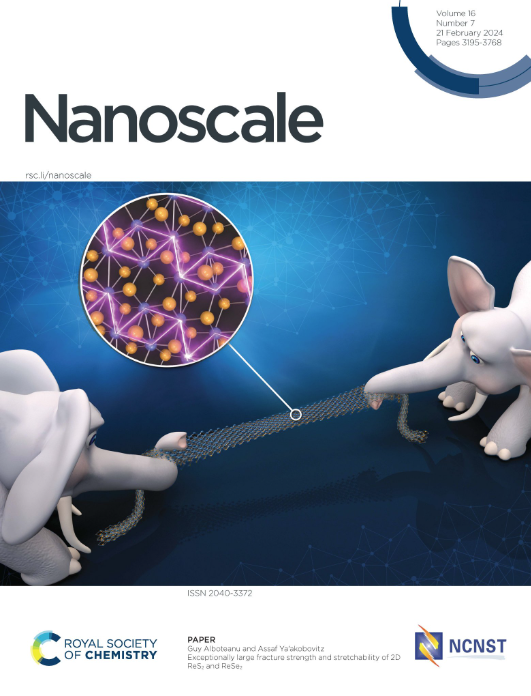Preparing an MnS@CN composite with lasagna-like nanostructure through pyrolysis of an organic hybrid manganese sulfide for electrochemical lithium storage.
IF 5.1
3区 材料科学
Q1 CHEMISTRY, MULTIDISCIPLINARY
引用次数: 0
Abstract
Carbon-coupled metal sulfide composites with rational nanostructures could be used as ideal anode materials for lithium ion batteries (LIBs). Herein, we solvothermally synthesized a crystalline organic hybrid manganese sulfide Mn(phen)2S6 (phen = 1,10-phenanthroline). Its structure featured an Mn(phen)2S6 molecule, in which the Mn atom was coordinated with two phen ligands and an S6 chain. The coordination between the Mn atom and phen/S6 ligands highlighted the potential of Mn(phen)2S6 as a precursor for synthesizing a carbon-coupled MnS composite via thermal treatment. After pyrolyzing Mn(phen)2S6 at 500 °C, an MnS@CN (CN = nitrogen-doped carbon) composite was generated. In particular, the MnS@CN composite possessed a lasagna-like nanostructure with MnS nanoparticles encapsulated in the interlayers of the nitrogen-doped carbon nanosheets. The lasagna-like nanostructure of MnS@CN promoted the charge transport and lithium-ion diffusion kinetics while also providing buffer space for the volume fluctuations of MnS nanoparticles during lithiation/delithiation. Owing to these advantages, MnS@CN offered an initial capacity of 680.7 mAh g-1 at 500 mA g-1, which was much higher than that of pure MnS (249.1 mAh g-1). Moreover, after 500 cycles, MnS@CN exhibited a capacity retention of 97.8%, which was also higher than that of pure MnS (34.1%). Thus, our study shows the potential of organic hybrid metal sulfides as precursors for preparing carbon-coupled metal sulfide composites with unique nanostructures for electrochemical lithium storage.通过热解有机杂化硫化锰制备具有千层面状纳米结构的MnS@CN复合材料,用于电化学锂存储。
具有合理纳米结构的碳偶联金属硫化物复合材料可作为理想的锂离子电池负极材料。本文采用溶剂热法合成了结晶型有机杂化硫化锰Mn(phen)2S6 (phen = 1,10-菲罗啉)。其结构为Mn(phen)2S6分子,其中Mn原子与两个phen配体和一个S6链配位。Mn原子与phen/S6配体之间的配位突出了Mn(phen)2S6作为通过热处理合成碳偶联MnS复合材料的前驱体的潜力。在500℃下热解Mn(phen)2S6,得到MnS@CN (CN =氮掺杂碳)复合材料。特别地,MnS@CN复合材料具有类似千层面的纳米结构,其中MnS纳米颗粒包裹在氮掺杂碳纳米片的中间层中。MnS@CN的千层面状纳米结构促进了电荷输运和锂离子扩散动力学,同时也为MnS纳米颗粒在锂化/衰减过程中的体积波动提供了缓冲空间。由于这些优点,MnS@CN在500 mA g-1时提供了680.7 mAh g-1的初始容量,远远高于纯MnS (249.1 mAh g-1)。此外,经过500次循环后,MnS@CN的容量保留率为97.8%,也高于纯MnS的34.1%。因此,我们的研究显示了有机杂化金属硫化物作为制备具有独特纳米结构的碳偶联金属硫化物复合材料的前驱体的潜力,用于电化学锂存储。
本文章由计算机程序翻译,如有差异,请以英文原文为准。
求助全文
约1分钟内获得全文
求助全文
来源期刊

Nanoscale
CHEMISTRY, MULTIDISCIPLINARY-NANOSCIENCE & NANOTECHNOLOGY
CiteScore
12.10
自引率
3.00%
发文量
1628
审稿时长
1.6 months
期刊介绍:
Nanoscale is a high-impact international journal, publishing high-quality research across nanoscience and nanotechnology. Nanoscale publishes a full mix of research articles on experimental and theoretical work, including reviews, communications, and full papers.Highly interdisciplinary, this journal appeals to scientists, researchers and professionals interested in nanoscience and nanotechnology, quantum materials and quantum technology, including the areas of physics, chemistry, biology, medicine, materials, energy/environment, information technology, detection science, healthcare and drug discovery, and electronics.
 求助内容:
求助内容: 应助结果提醒方式:
应助结果提醒方式:


